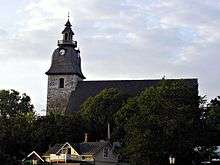Nådendal Abbey

Nådendal Abbey, (Swedish: Nådendalskloster), was a Bridgettine abbey in then-Swedish Finland, in operation from 1438 to 1591. The abbey was first situated in Masku, secondly in Perniö (1441) and finally in Naantali in 1443. It was one of six monasteries in Finland during the Middle Ages, and, as a double monastery, the only one which accepted women.
History
Nådendal Abbey received many donations during the 15th century. During the Swedish Reformation of 1527, however, many donations was taken back by the donors' families. The abbey was barred from accepting new novices and many members left, among them the Abbess Valborg Joakimsdotter Fleming (reign 1526–1531). In 1554, the church silver was confiscated and the abbey was visited by the Lutheran Bishop Mikael Agricola, at which time its members was required to promise to become "evangelical Christians", to refrain from venerating the saints and reading the revelations of Saint Bridget in public.
In 1556, the estates and assets of the abbey were confiscated, but the remaining members of the monastic community were allowed a royal pension. The last recognized Abbess, Birgitta Knutsdotter, died in 1577. By then, there were only four nuns and one monk left. The last nun, Elin Knutsdotter, was granted an allowance in 1584 and died in 1591.
See also
References
- Nordisk familjebok, 1904–1926.
Coordinates: 60°28′16″N 22°00′55″E / 60.471091°N 22.015357°E